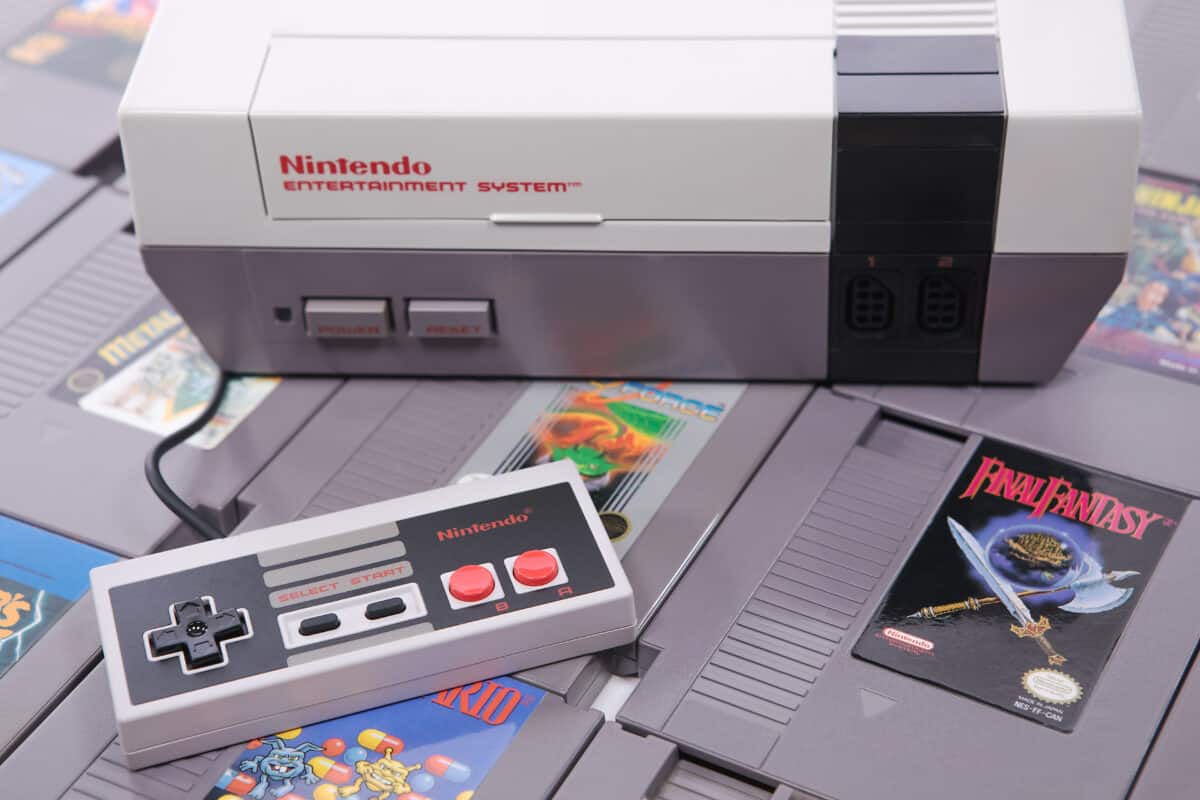For millions of gamers, the video game crash of 1983 is all but a distant memory, something to read about in history books. It’s hard to imagine the idea that an almost $200 billion dollar industry today almost never was. Except, it almost happened, and had it lasted, the entertainment world might look very different from what it does today.
How did this giant industry once come crashing down to the point of near obliteration? The story is one of oversaturation, the rise of personal computers, and a Japanese gaming company with a plumber. Let’s take a look at the great video game crash of 1983 and how it almost upended one of the biggest industries in the world.
What Was the Video Game Crash of 1983?
The most basic explanation is that this was the time when video game sales dropped 97% from $3.2 billion in 1982 to $100 million by 1985. As the world gave rise to Atari and a dozen other consoles like it, the industry exploded on the scene, and parents and kids gobbled up consoles just as quickly as they hit store shelves. Unfortunately, it was too much of a good thing as consumers had too many consoles to choose from, which created significant levels of confusion for would-be buyers.
Eventually, the video game market was bound to hit a breaking point, and that’s exactly what happened in 1983. Almost overnight, the industry was decimated, leading to the bankruptcy of many video game console manufacturers and unsold games destined for landfills in the desert. The abrupt end of the second generation of American console video gaming led many analysts to think the video game console war was forever over.
Rest assured that as much as rumors would have you believe so, the release of E.T. The Extra-Terrestrial for the Atari 2600 was not the main cause of the 1983 crash.
What Caused the Video Game Crash of 1983?
Although many historians like to point at one factor over another, the reality is that there wasn’t a single primary reason the video game crash of 1983 occurred. Instead, it was caused by a combination of factors that all led to the same implosion of the industry.
Oversaturation
In today’s video game world, and for the last twenty years or so, the video game industry has been dominated by a small number of players like Microsoft, Sony, and Nintendo. However, in 1983, the video game industry gave way to dozens of console choices from the likes of Atari, ColecoVision, Intellivision, Vectrex, Bally Astrocade, Magnavox Odyssey 2, and more.
Take, for example, the game, Q-Bert, which was available on nine different consoles in 1982 with barely any differences between its various console releases. There were very few console exclusives as we know them today, which meant differentiation between consoles was almost nonexistent.
This meant that you could buy a console for your home, your friends bought another, and, while you might have the same game title, you wouldn’t be able to play them together. It caused significant frustration for parents who were also flooded with too many games and not very good ones. There was a significant oversaturation of games themselves, and many of them were of inferior quality and were rushed to market.
Executives at Mattel, manufacturers of the Intellivision console, once acknowledged they released two years’ worth of products into their sales channels during a one-year period and something had to give. Retailers simply didn’t have enough shelf space to support all of the available consoles, plus the huge libraries of games that were constantly growing bigger.
The Rise of Personal Computers
Whereas PC gaming and consoles peacefully (sometimes!) co-exist in today’s gaming world, that wasn’t the case in the early 1980s. As personal computers started to become inexpensive enough to own, sales grew, and as a result, so did their gaming abilities.
The rise of personal computers saw games like the original Microsoft Flight Simulator, and Lode Runner come to life. Parents saw far more potential in buying computers that could be used for multiple tasks beyond gaming, like word processing and keeping track of expenses.
What is often ignored about the rise of personal computers is that a price war broke out to get to the bottom as manufacturers wanted to usurp the video game console in the home. To do that, they had to get prices down to the same level as video game consoles, creating a price war that would lead parents and console buyers to choose either a personal computer or a video game console.

©Gorodenkoff/Shutterstock.com
Poor Gaming Quality
While E.T. The Extra-Terrestrial may be widely considered the worst video game of all time, it’s hardly the only bad game to release in the early 1980s. There was a mad rush to release as many games as possible for all of the various consoles available in the early 1980s, and, as a result, quality assurance was almost non-existent.
Video game companies like Atari wanted to see revenues increase as consoles were often sold at a loss. The result was shorter development cycles than would typically be required and little to no playtesting before going to market. This led to near-unplayable games in 1982, and it quickly turned off millions of gamers who were otherwise big video game buyers.
Consumer Confidence
Ultimately, all of the above factors came to a head, and the result was the video game crash itself. There is no single day that can be pointed at as a turning point, but consumer confidence quickly dropped across this time period. The lack of quality of gaming titles turned off buyers, who quickly turned their attention to PC gaming, where stricter quality standards existed.
Immediate Impact of the Video Game Crash of 1983
Looking back, the video game crash of 1983 is a stark reminder for the current industry of what can happen if strict guardrails are ignored. Atari lost more than $350 million dollars and laid off more than one-third of its staff during this period. While it would go on to release more consoles in the future, it never really recovered financially or regained its market position.
Magnavox would abandon the video game business entirely, and Imagic, a video game developer, was forced to cancel its IPO the day before it was set to go live on the stock market. ColecoVision would be pulled off the market in 1985, and similar stories played out over and over across the industry. Retailers that were flying high off the back of huge video game sales folded as well.
The Video Game Industry Bounces Back
You already know how the story ends, as video games are a huge part of today’s entertainment world. However, back in 1985, there was little uncertainty about whether the industry would ever recover. As it turns out, the industry did recover, and there are two major reasons why.

©robtek/Shutterstock.com
Personal Computers
Albeit the less critical of the two reasons that helped the video game industry recover, the continued sale of personal computers definitely helped. Video game developers like Activision and Electronic Arts were able to keep making games for personal computers from Commodore and Tandy, so they were able to maintain revenue streams.
Nintendo Entertainment System
At the same time, the video game crash was occurring in the U.S.. The Japanese game industry was shifting its focus from arcade gaming to home consoles. The release of Nintendo’s Famicom system in Japan was a huge hit, with 19% of Japan’s population at the time owning at least one Famicom system. As a result, Nintendo set its eyes on North America.
However, to bring its console to the U.S. market, it had to market it as anything but a video game console. This gave rise to the name Nintendo Entertainment System which sounds like anything but a video game console. As retailers pushed back against adding another video game console to their store shelves, still reeling from the crash, Nintendo gave up the Famicom name entirely in the U.S.
Nintendo would help restore consumer confidence by creating its “Seal of Quality,” which required developers to go through Nintendo for approval and pay to release their games on the NES. Nintendo also forced developers to scale back on the volume of their releases, limiting each developer to only five games for the NES per year.
As the story goes, Nintendo was successful, and by 1989, the video game market in the U.S. had grown to more than $5 billion in sales. Nintendo was selling millions of consoles and had a dominant market position that gave way to the likes of the TurboGrax16 and the Sega Genesis. The rest, as they say, is history.
Legacy of the 1983 Video Game Crash
The rise of the Nintendo Entertainment System has seen the video game industry at large make every effort to not repeat mistakes of the past. Thankfully, over the last 30 years, Nintendo, Sega, Sony, and Microsoft have worked hard at controlling the supply of games available for their respective consoles.
Whereas quality control was an afterthought in the early 1980s, today, it’s the cause of many game delays to ensure when a title is released. It’s as bug-free as possible. As annoying as that might be for fans looking forward to releases of upcoming games, the worst thing a developer can do is release a game before it’s ready.
Because of these quality controls, the video game industry is now an entertainment behemoth. Consoles and games are consistently at the top of holiday wish lists, and the industry is projected to grow to more than $500 billion in total revenue by 2030.

Could There Be Another Video Game Crash?
It’s possible, but unlikely. As we mentioned above, some of the factors that contributed to the 1983 Video Game Crash were oversaturation of the market, poor quality games, and major changes in technology. Any of these could happen, but it’s unlikely that they would all happen at once like they did in 1983.
There are, of course, corresponding factors that could help to prevent another crash. Some of these include:
- The rise of mobile gaming, which has helped to diversity the video game market, thus reducing the risk of oversaturation
- The increasing popularity of digital distribution, which has made it easier for consumers to purchase games. Like the first point, this one helps reduce the risk of market saturation while making games more accessible to gamers.
- The growing popularity of esports, which has helped to raise the profile of the gaming industry and attracted new consumers to the market.
Up Next
- Nintendo’s First M-Rated Game: The History of the Mature Rating — M-rated video games are intended for players 17 years old and up. Do you know what your kids are playing?
- The Absolute Best Atari Action Games of All Time — Take a look at the video games that defined a generation.
- The 7 Absolute Best NES Sandbox Games of All Time — If your idea of the ultimate video game is going anywhere, doing anything, and interacting with whatever you want, check out this list of NES sandbox games.
The image featured at the top of this post is ©Dmitry Naumov/Shutterstock.com.







